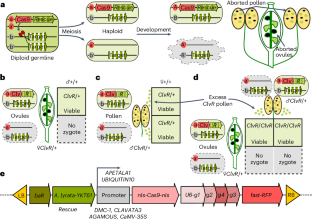2024-06-26 カリフォルニア工科大学(Caltech)
<関連情報>
- https://www.caltech.edu/about/news/a-new-crispr-driven-technology-for-gene-drive-in-plants
- https://www.nature.com/articles/s41477-024-01701-3
クリーブ&レスキュー配偶子キラーが植物における遺伝子ドライブの条件を作り出す Cleave and Rescue gamete killers create conditions for gene drive in plants
Georg Oberhofer,Michelle L. Johnson,Tobin Ivy,Igor Antoshechkin & Bruce A. Hay
Nature Plants Published:17 June 2024
DOI:https://doi.org/10.1038/s41477-024-01701-3

Abstract
Gene drive elements promote the spread of linked traits and can be used to change the composition or fate of wild populations. Cleave and Rescue (ClvR) drive elements sit at a fixed chromosomal position and include a DNA sequence-modifying enzyme such as Cas9/gRNAs that disrupts endogenous versions of an essential gene and a recoded version of the essential gene resistant to cleavage. ClvR spreads by creating conditions in which those lacking ClvR die because they lack functional versions of the essential gene. Here we demonstrate the essential features of the ClvR gene drive in the plant Arabidopsis thaliana through killing of gametes that fail to inherit a ClvR that targets the essential gene YKT61. Resistant alleles, which can slow or prevent drive, were not observed. Modelling shows plant ClvRs are robust to certain failure modes and can be used to rapidly drive population modification or suppression. Possible applications are discussed.


